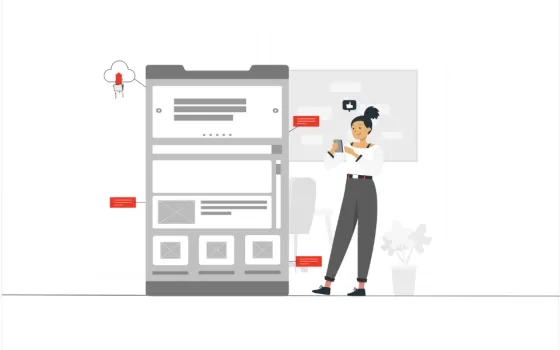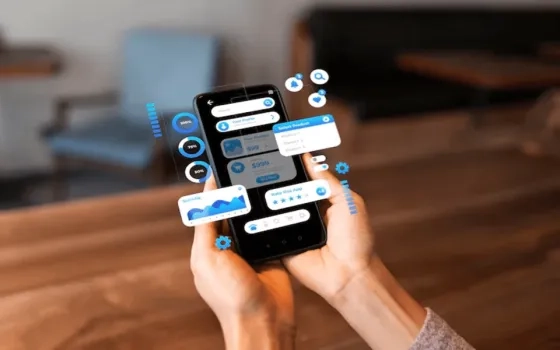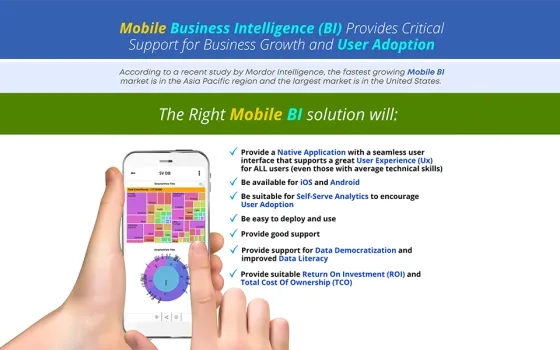Over the years, UI UX has evolved into an essential process within enterprises. While 2022 was a year of change and transition for many organizations, 2023 is an opportunity to level up your user interface (UI) and user experience (UX). Just as trends in fashion and lifestyle keep changing, the same applies to UI UX in the digital world. Assimilating these changes and incorporating new approaches for building UI UX can determine the success of your product. The article will discuss the trends and best practices for enterprise UI UX that you should be aware of to create an excellent product in 2023.
But first, a quick recap of the need for UI UX in an enterprise.
The Need of UI UX In 2023
UI UX development plays a significant part in today’s web development. Here’s why:
1. Enhanced customer satisfaction equals improved ROI:
Intuitive navigation and engaging content lie at the heart of a good website. In addition, meeting your client’s expectations facilitates brand loyalty. Even better, your users will be more likely to recommend your business to others, generating more conversions. The net result is improved ROIs.
2. Enables greater personalization:
UI UX provides opportunities for audience segmentation and personalized content. This enables companies to offer highly targeted experiences that speak directly to user needs and wants, making them feel valued. Incorporating thoughtful UI UX helps convert users into loyal customers and drives your actual sales.
3. Enhances your credibility:
A strategic UI UX design enhances user satisfaction and brand engagement. As your client develops strong associations with your brand, it sets the tone for credibility and trustworthiness in your enterprise. The natural progression is enterprise growth!
4. Time and cost efficiencies:
Investing in design helps minimize niggles that clients may encounter on your site. Furthermore, a complete and well-designed product does not require costly upgrades. In other words, you save valuable time and money that upgrades need.
Enterprise UI UX in 2023
As per studies, a well-designed UI could increase your website’s conversion rate by up to 200%. Likewise, a better UX design could generate up to 400% conversion rates.
At a glance, the top trends in UI UX for 2023 include generative AI, implementation of large font size, accessibility, light mode, augmented reality, data-driven design personalization, and others.
Regardless of the changes, your UI and UX teams must harmonize well to create an effective product.
Let’s look at the key trends and best practices for user interface and user experience in 2023.
UX Trends for 2023 for Enterprise Products
1. Implementing Speedy Page Loads:
It is common knowledge that as page load time increases from 1 second to 3 seconds, the probability of bounce increases 32%.
At one point or another, we all have switched to a different resource, refusing to wait until a page loads. When launching a new product, a fast response is of great significance for enterprises as it’s their reputation on the line.
For this reason, the design team, comprising UX designers, should focus on optimizing page response.
Working with video file formats, server stability, reducing the number of used typefaces etc., will help improve the workflow and design, enhancing the overall UX.
For a site’s mobile version, using technologies such as accelerated mobile pages (AMP) technology can improve page speed on smartphones with the help of unique HTML and CSS versions. In addition, since AMP version loads are faster, it leads to an enhanced user experience, facilitating conversion and retention.
2. Use of Augmented Reality (AR) and Virtual Reality (VR):
Virtual reality and augmented reality have become one of the leading UX industry trends. You can expect this to continue in the coming years.
AR/VR helps enterprises offer users a more immersive experience. While AR augments real-world scenarios with sound, graphics, and other computer-generated input, VR leverages technology to simulate an environment. As a result, both are extremely useful in enabling enterprises to create a unique customer experience.
With widespread use in the education, retail, and healthcare sectors, its implementation in marketing, graphic, and website design in 2023 will be a game changer.
In fact, in 2023, you can expect to see AR technology being more widely adopted in apps to enhance user experience with advanced features and functionalities.
3. Incorporating AI Technology:
Most are already familiar with AI through technologies like Siri and Alexa. Nonetheless, in the future, AI will encompass more impressive products.
In the UX space, AI technology has already made an impact. Designers have already been leveraging AI tools for various reasons, from generating color palettes and drawing fictional portraits for personas to enhancing images or deleting backgrounds.
However, in 2023, the role of AI within UX design will likely increase, especially in areas such as user analysis and information architecture. For example, based on best practices identified on the web, enterprises can leverage AI to develop a large number of wireframes. This time saver will enable designers to reprise and propose possible solutions quickly.
AI technology could also enable designers to submit their screens and receive AI-generated heat maps reflecting the practicality of their design.
4. Creating Mobile-first Designs:
As per studies, mobile accounts for nearly half of the web traffic globally. In the second quarter of 2022, mobile devices (excluding tablets) generated almost 60% of website traffic worldwide.
Against this backdrop, enterprise UX will undoubtedly focus on developing suitable designs for smartphones and then rebuilding them using the same toolkit for desktops, tablets, and other platforms.
In 2023, enterprise UX will have to adopt responsive design practices that can be scaled on different devices and screen resolutions.
Likewise, UX designers will need to clearly understand the scenarios when a device is used.
Ambient noises or light absence (also known as context-first design) will significantly influence UX and become more popular.
5. Use of Animated Illustrations:
These illustrations, which appear on websites, landing pages, mobile screens, and images, impart a human element and natural look to an enterprise’s overall UX design.
They enhance the quality of narration, be it the brand’s story, its services, and/or products. In addition, incorporating motion in the illustrations helps capture user attention and promotes engagement with the content.
6. Effective Storytelling:
For enterprises, storytelling is an effective medium to engage and attract users. It can build a connection between the user and the product when executed well. This promotes better retention and helps drive conversions.
UX designers can effectively leverage storytelling to explain the brand and its concepts and enhance the overall user experience.
For UX purposes, create stories that are relevant to user needs and interests. Also, ensure that stories are presented in an understandable and engaging way, such that it captures the user’s attention all through.
Implementing these practices in storytelling can help UX designers create compelling and memorable UX experiences for their users.
7. 3D Graphics:
In 2023, 3D graphics will be a significant trend in UI UX. 3D graphics help users picturise the product, and it enhances user experience. For enterprises, this could mean incorporating 3D visuals in their products like tours, presentations, or simulations.
3D graphics help UX designers increase user engagement by leveraging the principles of photorealism.
Besides enabling 360-degree presentations for improved UX design, 3D graphics also allow UX designers to strike an effective balance between readability and user navigation. This is made possible by using background elements that have seamless 3D movement.
8. User Authenticity – Behavior Design and Interactive Design:
Despite the rise in automation and AI technologies, users prefer to be understood as human beings.
Where UX designers continuously look to enhance the user experience, behavior design can play a significant role. Moreover, in the era of big data, behavioral design appears all set to play a vital role in enterprise UX.
Designers adopting this approach must factor in the psychological reactions of users and try to influence their behavior desirably.
For example, by using color theory, it is possible to create a soothing interface for a meditation app. Likewise, UX designers can enhance the experience of an educational app and make it more engaging by using gamification principles.
In short, a good understanding of behavioral science can help UX designers develop more effective and interesting designs.
9. Personalization Capabilities:
Everyone appreciates UX designers creating browsing experiences for the user’s convenience and needs.
By offering personalization capabilities, including location-specific results or recommendations that consider their browsing behavior, enterprises can create valuable user experiences.
Simply put, in a rapidly expanding digital landscape, putting your users at ease on your site with these personalization features will make it appear that you are personally addressing their needs.
10. Login Without Passwords:
Many a time, passwords can leave users more confused than before.
According to the survey in the US, nearly 6 out of 10 participants (57%) said they forgot their new password soon after resetting it. Even more significantly, two in three Americans stated they would avoid visiting websites or accounts for which they had forgotten their passwords.
Quite literally, password anxiety is for real. So, it follows that when designing enterprise UI, password forgetfulness is a customer issue that must be addressed.
When viewed through the lens, the real issue lies with protocols of password creation. For example, users must include upper-lower case character combinations, special characters, and numerals mandatorily for security reasons. However, these stringent requirements increase the complexity of the password and result in users forgetting them almost immediately.
One of the emerging UX design trends many big brands have begun implementing include “passwordless” logins. For instance, the simple transition involves logging in through Google, social media accounts, biometric scans, phone unlock patterns, and PINS.
The concept of passwordless logins is one of the top UX trends for 2023. Even more significantly, it is expected to surpass passwords as the primary login method within the next few years.
UI Trends for 2023 for Enterprise Products
1. Minimalist Interface:
Minimalism traces its origin to geometric abstractions in paintings and sculptures.
In UI, minimalism enhances user-friendliness while supporting intuitive, buttonless, intentional engagement with the interface’s core components. In addition, its sophistication and uncluttered appearance help to create an aesthetically pleasing interface.
Typical traits of minimalist UI comprise large spare areas, conciseness, well-balanced proportions, and compositions with a high focus on functionality. In addition, a rich visual hierarchy and a deeper focus on core details enable more meaningful user interactions.
2. Custom Illustrations:
In UI, illustrations promote user-friendly interactions on the webpage. Custom illustrations help interfaces distinguish from those of the competition.
In 2023, you can spruce up your enterprise UI by using Illustrations as hero images for your review, landing pages, and other critical pages while balancing the artwork with your business objectives.
You can also use illustrations that match your target audiences’ expectations to convey your brand message, visually express emotions, and enhance your brand’s awareness and noticeability.
3. Voice UI:
Voice UI helps your user to engage with a system using voice or speech commands. Stepping into 2023, the role of Voice UIs is set to evolve even further.
According to Statista, the installed base of smart speakers in the United States alone was predicted to grow from 47.3 million units in 2018 to approximately 95 million units in 2022.
You can enrich user experiences with voice interactions by understanding how people communicate naturally with their voices and implementing specific guidelines for voice UI.
Likewise, offering visual feedback will help users assimilate what they hear. Also, incorporating appropriate options and providing guidance about the functionalities will allow users to associate their voice commands with the desired outcome.
4. Bright UI:
UI designers must be well-versed in applying colors and leveraging color theory technology. In fact, the use of vibrant colors and gradients for enterprise UI is the current flavor of the season. And rightfully so!
When you use bright UI, the color contrasts improve legibility. In addition, bright colors present the visual hierarchy more effectively, enabling easy navigation and intuitive interactions.
Nonetheless, higher contrast levels may not always be suitable. It is, therefore, advisable to use high contrasts exclusively for highlighting and contrasting elements. Further, when you apply one color to several elements, it showcases their connection with each other.
In addition, another technique to help establish consistency of visual solutions involves using similar colors in logos and websites or mobile apps. Not only does it help capture the users’ attention in a highly competitive space, but it also facilitates the increase in brand awareness.
5. Neumorphism:
This UI style which features a flat design with soft shadows and highlights, may be one of the prime trends of 2023 for enterprise UI.
The term Neumorphism UI Trend is most often used in UI to describe interface objects that mimic their real-world counterparts in their appearance and/or how users interact with them. For example, the recycle bin icon used for deleting files is a typical example of neumorphism.
Using a neumorphic card as an elevated shape made of a material similar to the background will help create a detailed design replete with highlights, shadows, and glow.
By implementing neumorphism, you can infuse a fresh realism that helps you distinguish from the competition.
6. Asymmetrical Layout:
Stretch the limits of your conventional web design successfully by using asymmetrical layouts.
Asymmetrical layouts will help infuse a unique personality and character into your design. Furthermore, you can experiment with dynamic compositions focused on your user needs.
Using white spaces on the surface, layering imagery, typography, and other creative design elements will impart character and depth to your UI design layout.
7. Immersive Scrolling:
This is one of the significant UI UX design trends to watch for in 2023. Immersive scrolling enables designers to control what and how the content is displayed to viewers.
Immersive scrolling typically involves presenting the user with content in a more planned and narrative way.
The use of well-ordered animations and other engaging elements enables the user to interact positively with the site. It incites curiosity and compels users to engage with the content, whereas earlier, they would generally give it a skip.
Nonetheless, when designing for improved UI, enterprises should customize their immersive scrolling capabilities to match marketing and business goals. Also, care should be taken to ensure that it aligns with the brand.
8. Use of Large Font Size:
For a quick peek into top UI trends for 2023, simply glance through the websites of some of the most reputed global brands, such as Apple, Toyota, McDonald’s, and Microsoft.
A typical pattern of home pages emerges, comprising neat websites that feature only the most critical data and categories.
These sites use big font sizes and large H1, H2, H3, and text, too!
Enterprise websites still cluttered with unimportant information and images should be immediately addressed in 2023 and updated accordingly.
Going by current trends, employing large fonts and images is almost certain to continue beyond 2023.
9. Usage of Card UI Component:
Another top trend in UI for 2023 is the increased use of card components in design. This especially holds for mobile apps or mobile versions of websites.
The card component acts as a resourceful information holder as it can present virtually any information set. This includes videos, product previews, images, blog posts, instructions, and tasks.
When used appropriately, the cards can help enterprise UI experts to arrange the information on the interface efficiently. Consequently, this greatly enhances user experience.
You can refer to the existing design systems of other brands for ideas, handy hints, or guidelines for implementing card design.
10. Accessibility:
Factors such as culture, language, age, gender, and physical or mental capabilities matter in making a product more accessible.
UI designers should take into consideration the unique traits of their users, as the spirit of inclusivity enables businesses to reach out to their target audience.
When designing the UI, creators should identify the design elements that specific user groups cannot access, for example, colorblindness.
Taking the time to create a design that caters to a broader audience is essential for any product looking to make access easier and more comfortable for users.
As a best practice, enterprise UI design teams should invite specific user groups when testing new builds. This will help in product development and enable users to interact with its content in different ways.
Voice-to-speech and video subtitles are examples of what the UI teams need to try out, leveraging different tools to implement these features. For instance, W3C guides can help assess if your website and mobile design are accessible by users having color blindness.
Conclusion
The UI UX space in 2023 points towards more creative, intuitive, and accessible designs. With websites becoming more complex and the development of immersive technologies, enterprise UI UX designers need to stay ahead of the curve.
By understanding the latest trends and anticipating what’s next in design, enterprises can take their product designs to a new level. The objective is to create experiences that are tailored to users’ expectations. In addition, companies should focus on being creative and innovative to ensure their designs stand out in the crowd.
By adopting UI UX design principles, companies can improve their products’ usability, increase customer satisfaction and loyalty, and drive business growth. With these best practices for UI UX design practices in place, enterprises can build user-friendly applications with attractive visuals that will stay ahead of the competition.
The UI UX trends for 2023 are already in motion, so it’s crucial to strategize and plan your product design accordingly. More significantly, many of these trends are dynamic and will likely extend beyond 2023 to the coming decade.
By utilizing the best practices mentioned above, enterprises can instill a sense of confidence in their product designs and ensure they keep up with the ever-changing UI UX landscape.



















